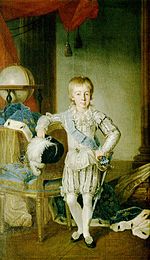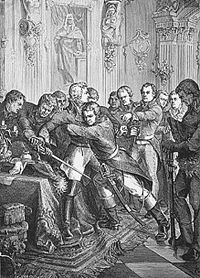Gustav IV Adolf
This article needs additional citations for verification. (February 2022) |
| Gustav IV Adolf | |
|---|---|
Riddarholm Church, Sweden-Norway | |
| Spouse | |
| Issue | |
Lutheran | |
| Signature |  |
| Swedish royalty |
| House of Holstein-Gottorp |
|---|
 |
| Adolf Frederick |
| Gustav III |
| Gustav IV Adolf |
|
| Charles XIII |
|
Gustav IV Adolf or Gustav IV Adolph[1] (1 November 1778 – 7 February 1837) was King of Sweden from 1792 until he was deposed in a coup in 1809. He was also the last Swedish monarch to be the ruler of Finland.
The occupation of Finland in 1808–09 by Russian forces was the immediate cause of Gustav Adolf's violent overthrow by officers of his own army. Following his abdication on 29 March 1809, an Instrument of Government was hastily written, which severely circumscribed the powers of the monarchy. The "Instrument" was adopted in 1809 on 6 June, the National Day of Sweden now as well as in his time. It remained in force until replaced in 1974. The crown, now with strictly limited powers, passed to Gustav Adolf's uncle Charles XIII.[2]
Early life

Gustav Adolf was born in
Gustav Adolf was under the tutelage of
In August 1796, his uncle the regent arranged for the young king to visit
Politics
Gustav Adolf's prompt dismissal of the generally detested
Loss of Finland
His reign was ill-fated and was to end abruptly. In 1805, he joined the Third Coalition against
Coup d'état and abdication

Gustav Adolf was arrested through a conspiracy of army officers.
On 7 March 1809,
On 29 March Gustav IV Adolf, to save the crown for his son, voluntarily abdicated; but on 10 May the
In exile Gustav Adolf used several titles, including Count
Arms
 Coat of Arms of King Gustav IV Adolf of Sweden
|
Ancestry
| Ancestors of Gustav IV Adolf | ||||||||||||||||||||||||||||||
|---|---|---|---|---|---|---|---|---|---|---|---|---|---|---|---|---|---|---|---|---|---|---|---|---|---|---|---|---|---|---|
| ||||||||||||||||||||||||||||||
Family


In 1797 he married Frederica Dorothea Wilhelmina of Baden, with whom he had five children:
- Crown Prince Habsburgs of Austria, and with his wife Princess Louise Amelie of Baden, fathered a son who died in infancy, and a daughter, Carola, the wife of Albert, King of Saxony. She died childless.
- Princess Carl XVI Gustaf of Swedenis thus Gustav IV's heir.)
- Prince Carl Gustaf, Grand Duke of Finland (2 December 1802 – 10 September 1805)
- Princess Amalia (22 February 1805 – 31 August 1853); unmarried and without issue
- Princess Cecilia (22 June 1807 – 1844); married Augustus, Grand Duke of Oldenburg, and had issue.
By 1812, Gustav Adolf divorced his consort, and following this he had several mistresses, among them Maria Schlegel, who gave him a son, Adolf Gustafsson.
See also
Notes
- ISBN 0-86350-194-Xpp. 125, 134, 194, 207
- ^ Cronholm, Neander N. (1902). A History of Sweden from the Earliest Times to the Present Day. ch 37 pp. 203–219
- ^ a b c d e Bain 1911.
References
- H. Arnold Barton, Scandinavia in the Revolutionary Era, 1760–1815, 1986, ISBN 0-8166-1392-3.
- Sten Carlsson, Gustaf IV Adolf, 1946.
- This article incorporates text from a publication now in the public domain: Bain, Robert Nisbet (1911). "Gustavus IV.". In Chisholm, Hugh (ed.). Encyclopædia Britannica. Vol. 12 (11th ed.). Cambridge University Press. p. 738.
External links
- . New International Encyclopedia. 1905.
- . The American Cyclopædia. 1879.

